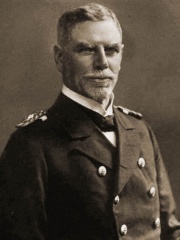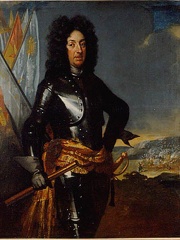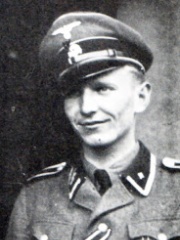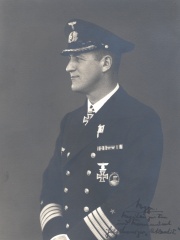



The Most Famous
MILITARY PERSONNELS from Denmark
This page contains a list of the greatest Danish Military Personnels. The pantheon dataset contains 2,058 Military Personnels, 5 of which were born in Denmark. This makes Denmark the birth place of the 43rd most number of Military Personnels behind Latvia, and Switzerland.
Top 5
The following people are considered by Pantheon to be the most legendary Danish Military Personnels of all time. This list of famous Danish Military Personnels is sorted by HPI (Historical Popularity Index), a metric that aggregates information on a biography's online popularity.

1. Ubba (1000 - 878)
With an HPI of 77.10, Ubba is the most famous Danish Military Personnel. His biography has been translated into 27 different languages on wikipedia.
Ubba (Old Norse: Ubbi; died 878) was a 9th-century Viking and one of the commanders of the Great Heathen Army that invaded Anglo-Saxon England in the 860s. The Great Army appears to have been a coalition of warbands drawn from Scandinavia, Ireland, the Irish Sea region and Continental Europe. There is reason to suspect that a proportion of the Viking forces specifically originated in Frisia, where some Viking commanders are known to have held fiefdoms on behalf of the Franks. Some sources describe Ubba as dux of the Frisians, which could be evidence that he also associated with a Frisian benefice. In 865, the Great Army, apparently led by Ivar the Boneless, overwintered in the Kingdom of East Anglia, before invading and destroying the Kingdom of Northumbria. In 869, having been bought off by the Mercians, the Vikings conquered the East Angles, and in the process killed their king, Edmund, a man who was later regarded as a saint and martyr. While near-contemporary sources do not specifically associate Ubba with the latter campaign, some later, less reliable sources associate him with the legend of Edmund's martyrdom. In time, Ivar and Ubba came to be regarded as archetypal Viking invaders and opponents of Christianity. As such, Ubba features in several dubious hagiographical accounts of Anglo-Saxon saints and ecclesiastical sites. Non-contemporary sources also associate Ivar and Ubba with the legend of Ragnar Lodbrok, a figure of dubious historicity. Whilst there is reason to suspect that Edmund's cult was partly promoted to integrate Scandinavian settlers in Anglo-Saxon England, the legend of Ragnar Lodbrok may have originated in attempts to explain why they came to settle. Ubba is largely non-existent in the Icelandic traditions of Ragnar Lodbrok. After the fall of the East Anglian kingdom, leadership of the Great Army appears to have fallen to Bagsecg and Halfdan, who campaigned against the Mercians and West Saxons. In 873, the Great Army is recorded to have split. Whilst Halfdan settled his followers in Northumbria, the army under Guthrum, Oscytel and Anwend struck out southwards and campaigned against the West Saxons. In the winter of 877–878, Guthrum launched a lightning attack deep into Wessex. There is reason to suspect that this strike was coordinated with the campaigning of a separate Viking force in Devon. This latter army is reported to have been destroyed at Arx Cynuit in 878. According to a near-contemporary source, this force was led by a brother of Ivar and Halfdan, and some later sources identify this man as Ubba himself.

2. Maximilian von Spee (1861 - 1914)
With an HPI of 68.59, Maximilian von Spee is the 2nd most famous Danish Military Personnel. His biography has been translated into 37 different languages.
Maximilian Johannes Maria Hubert Reichsgraf von Spee (22 June 1861 – 8 December 1914) was a German naval officer in the Imperial German Navy (Kaiserliche Marine), who commanded the East Asia Squadron during World War I. Spee entered the navy in 1878 and served in a variety of roles and locations, including on a colonial gunboat in German West Africa in the 1880s, the East Africa Squadron in the late 1890s, and as commander of several warships in the main German fleet in the early 1900s. During his time in Germany in the late 1880s and early 1890s, he married his wife, Margareta, and had three children, his sons Heinrich and Otto and his daughter Huberta. By 1912, he had returned to the East Asia Squadron as its commander, and was promoted to the rank of Vizeadmiral (Vice Admiral) the following year. Following the outbreak of World War I in July 1914, Spee led his squadron across the Pacific to the coast of South America. There on 1 November, he defeated the British 4th Cruiser Squadron under Rear Admiral Christopher Cradock in the Battle of Coronel, sinking two of Cradock's cruisers and forcing his other two ships to retreat. A month later, Spee decided to attack the British naval base in the Falkland Islands, but a superior British force surprised him. In the ensuing Battle of the Falkland Islands, Vice Admiral Doveton Sturdee's squadron, which included two powerful battlecruisers, destroyed the East Asia Squadron. Spee and his two sons, who happened to be serving on two of his ships, were all killed, along with about 2,200 other men. Spee was hailed as a hero in Germany, and several ships were named in his honor, including the heavy cruiser Admiral Graf Spee, which was built in the 1930s and was scuttled after the Battle of the River Plate during World War II.

3. Adam Ludwig Lewenhaupt (1659 - 1719)
With an HPI of 64.72, Adam Ludwig Lewenhaupt is the 3rd most famous Danish Military Personnel. His biography has been translated into 26 different languages.
Adam Ludwig Lewenhaupt (15 April 1659 – 12 February 1719) was a Swedish general, best known for his participation in the Great Northern War.

4. Søren Kam (1921 - 2015)
With an HPI of 59.08, Søren Kam is the 4th most famous Danish Military Personnel. His biography has been translated into 17 different languages.
Søren Kam (2 November 1921 – 23 March 2015) was a Danish junior officer in the Waffen-SS of Nazi Germany during World War II. He was wanted for murder in Denmark and listed by the Simon Wiesenthal Center as one of the most wanted Nazi war criminals.

5. Bernhard Rogge (1899 - 1982)
With an HPI of 57.33, Bernhard Rogge is the 5th most famous Danish Military Personnel. His biography has been translated into 15 different languages.
Bernhard Rogge (4 November 1899 – 29 June 1982) was a German naval officer who, during World War II, commanded a merchant raider. Later, he became a Konteradmiral in West Germany's navy. Rogge became a Vizeadmiral (vice-admiral) by the end of World War II, and, when the West German navy was established after the war, returned to service as a Konteradmiral (rear-admiral). He also was one of the few German officers of flag rank who was not arrested by the Allies after the war. This was due to the way he had exercised his command of Atlantis.
People
Pantheon has 5 people classified as Danish military personnels born between 1000 and 1921. Of these 5, none of them are still alive today. The most famous deceased Danish military personnels include Ubba, Maximilian von Spee, and Adam Ludwig Lewenhaupt.
Deceased Danish Military Personnels
Go to all RankingsUbba
1000 - 878
HPI: 77.10
Maximilian von Spee
1861 - 1914
HPI: 68.59
Adam Ludwig Lewenhaupt
1659 - 1719
HPI: 64.72
Søren Kam
1921 - 2015
HPI: 59.08
Bernhard Rogge
1899 - 1982
HPI: 57.33

